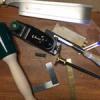I painted this desk top white (acrylic latex paint), sanding between coats. I rolled on 3 layers but wasn't happy with the resulting texture so sanded and sprayed on a final coat of (water based) spray paint.
I now have enough coats of paint and in general it looks good, but after the final sanding (P320) in preparation for the top coat, when you view from certain angles you see all the scratch marks (technically I think these are the high spots that have been sanded flat and now appear shinny). see pictures.
Do I just go ahead and start my top coat process (minwax polycrylic), and these will all disappear?
Do I need to add another layer of paint?
Do I need to sand the current paint layer more? and if so, should I use ROB instead of hand sanding linearly with the grain?
tia
Here is the general picture of the desk looking okay under normal lighting.
Photo May 28, 3 51 51 PM.jpg
Below are when viewing from certain angles.
Photo May 28, 3 52 07 PM.jpg
Photo May 28, 3 53 00 PM.jpg
Photo May 28, 3 51 29 PM.jpg





 Reply With Quote
Reply With Quote



